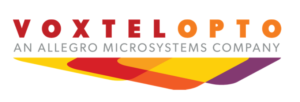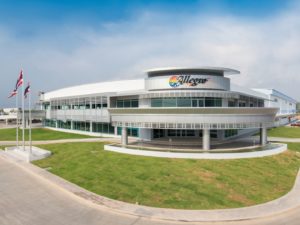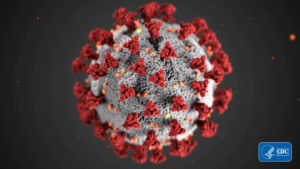
EXECUTIVE Q&A: RAVI VIG, PRESIDENT & CEO, ALLEGRO MICROSYSTEMS
 ATREG recently sat down with Ravi Vig, President and CEO of Allegro MicroSystems (Nasdaq: ALGM) based in Manchester, NH, to discuss the company’s successful IPO, plans for the future in the context of U.S.-China trade tensions, as well as the impact of the COVID-19 pandemic on their business. With more than 30 years of experience developing advanced semiconductor technology and application-specific algorithms, Allegro MicroSystems is a global leader in power and sensing solutions for motion control and energy-efficient systems, helping customers make breakthrough advancements in such areas as advanced mobility, green energy, and factory automation. Each year, the company ships over one billion units into these applications to support its 10,000+ customers around the globe, including over 50 automotive OEMs.
ATREG recently sat down with Ravi Vig, President and CEO of Allegro MicroSystems (Nasdaq: ALGM) based in Manchester, NH, to discuss the company’s successful IPO, plans for the future in the context of U.S.-China trade tensions, as well as the impact of the COVID-19 pandemic on their business. With more than 30 years of experience developing advanced semiconductor technology and application-specific algorithms, Allegro MicroSystems is a global leader in power and sensing solutions for motion control and energy-efficient systems, helping customers make breakthrough advancements in such areas as advanced mobility, green energy, and factory automation. Each year, the company ships over one billion units into these applications to support its 10,000+ customers around the globe, including over 50 automotive OEMs.
Allegro MicroSystems has been around for 30 years. How does your company manage to weather industry cycles in such a global competitive business?
In a word – innovation. Allegro is built on innovation. It’s in our DNA, it’s our foundation, it’s our tagline – innovation with purpose. This desire and drive to constantly move technology forward has allowed us to weather industry cycles. We have a broad product offering that reaches a global blue-chip tier-one customer base and services over 10,000 smaller customers. Our global sales diversification provides us with regional growth opportunities, but also minimizes the impact of localized sales slowdowns. We have a market-leading portfolio across our product families, including over 1,000 global patents allowing us to solve complex application problems. We believe our diversified product offering has enabled us to sustain through industry specific downturns.
 We are also entrenched in many of the macro growth trends such as electrified vehicles (EVs), data centers, industry 4.0, robotics, and green energy, all emerging sectors that require advanced semiconductor content. We have aligned our product and company strategies to focus on developing designs, packaging, and solutions to meet the standards that these applications require.
We are also entrenched in many of the macro growth trends such as electrified vehicles (EVs), data centers, industry 4.0, robotics, and green energy, all emerging sectors that require advanced semiconductor content. We have aligned our product and company strategies to focus on developing designs, packaging, and solutions to meet the standards that these applications require.
Allegro MicroSystems has recently conducted a successful IPO. What does being public mean to your company?
Many new doors have opened now that we are public. The opportunities I am most excited about are our company’s increased brand recognition on the global stage and the ability to attract top talent. A potential employee can see our track record of growth and profitability when considering us as an employer. New hires, as with many of our current employees, can participate in the company’s growth by buying stock or having it as part of their compensation structure.
Secondly, this can give us greater access to capital for research and development, acquisitions, or other investments in Allegro. To grow our business, we need to be able to invest in ourselves and our people. Being a public company can help us access capital for these purposes.
Finally, it brings us more brand awareness and into consideration amid potential customers. While we have been the top supplier of magnetic sensor ICs by market share for several years, there are potential customers who don’t know we exist. Going public has provided us with a new platform to promote Allegro.
Allegro MicroSystems’ recent acquisition of Voxtel has provided your company with an expanded portfolio of LiDAR photonic technologies. How do you view the future of the LiDAR market and what are the markets that have seen increased adoption of this technology?
 LiDAR is an enabler of the car of the future and, quite frankly, a necessary technology for these vehicles. Not only is it designed to allow fully autonomous vehicles to drive safely, but before that, it will be built into advanced driver assistance systems (ADAS) for semi-autonomous vehicles. At Allegro, we believe that LiDAR, especially eye-safe LiDAR, will be key to ensuring vehicles can safely move without a driver or with limited driver interaction.
LiDAR is an enabler of the car of the future and, quite frankly, a necessary technology for these vehicles. Not only is it designed to allow fully autonomous vehicles to drive safely, but before that, it will be built into advanced driver assistance systems (ADAS) for semi-autonomous vehicles. At Allegro, we believe that LiDAR, especially eye-safe LiDAR, will be key to ensuring vehicles can safely move without a driver or with limited driver interaction.
The Voxtel acquisition will allow us to be at the forefront of this exciting technology creation. We have high-powered, eye-safe lasers that, when combined with our power and magnetic sensor portfolio, can provide a full solution. We know the move to LiDAR will be gradual and systems will be added to vehicles for semi-autonomous needs before full autonomy. We don’t have a crystal ball to predict when this will happen, but we continue to innovate in this product set and drive our mission of a safer tomorrow.
Beyond the automotive space, we are seeing adoption of this technology in factory robotics, forklifts, drones, and construction equipment. We are building our solution to meet rigorous automotive safety standards which we believe will translate well into other markets where items need to move safely as they work with and for people.
With the progression of the CHIPS for America Act and other federal semiconductor initiatives, do you expect to take advantage of any potential funding available from the U.S. government? What Allegro projects do you see as targets for that funding?
Allegro would be interested in funding for research and design, as outlined in the CHIPS for America Act. This industry is one of constant change driven by technology innovation. Semiconductor companies have some of the highest rates of R&D spend of any industry and having the government help to support those initiatives would free up resources for other investments.
 At Allegro, we are laser-focused on creating a safer and more sustainable future. Having government support would provide resources for us to continue innovating in our ADAS and electrification solutions for safer, more efficient vehicles. Moving a car without a driver may seem like a dream today, but we are building those technologies now to make those systems a reality in the future.
At Allegro, we are laser-focused on creating a safer and more sustainable future. Having government support would provide resources for us to continue innovating in our ADAS and electrification solutions for safer, more efficient vehicles. Moving a car without a driver may seem like a dream today, but we are building those technologies now to make those systems a reality in the future.
We also continue to pursue the global green energy market. Further research dollars for devices in this space could make this energy source less cost-prohibitive. For instance, when we are designing semiconductors, we are always thinking about how we can be more efficient, use fewer components, or create a smaller footprint. While we may only be a small portion of a larger system, every PCB we can shrink or every dollar we can save a manufacturer brings the total cost of that system down and makes it more obtainable.
How has the recent progress towards a COVID-19 vaccine impacted your business outlook for 2021, particularly on the automotive front where you just announced an above 17% sequential growth? Do you expect a continued rebound from a down year in 2020?
 The semiconductor industry has proved quite resilient during the COVID-19 pandemic. We, along with many competitors, did experience some tough times at the beginning of the year. However, being deemed an essential business allowed us to continue to operate around the world. Our teams figured out how to safely work in this new environment to meet customer needs. Our factories did an outstanding job of satisfying customer demands despite workforce limitations. It was amazing to watch everyone come together to continue to drive Allegro forward and I would personally like to say a huge thank you to our global team.
The semiconductor industry has proved quite resilient during the COVID-19 pandemic. We, along with many competitors, did experience some tough times at the beginning of the year. However, being deemed an essential business allowed us to continue to operate around the world. Our teams figured out how to safely work in this new environment to meet customer needs. Our factories did an outstanding job of satisfying customer demands despite workforce limitations. It was amazing to watch everyone come together to continue to drive Allegro forward and I would personally like to say a huge thank you to our global team.
As you mention, we did experience growth in fiscal Q2 over fiscal Q1. Not only did automotive play a role in that, but the work-from-home world drove increased demand for our three-phase drivers in data centers.
I think progress towards a COVID-19 vaccine can only help our business. Our market and application diversity has allowed us to weather this storm well. While car production has slowed down, we know electric and autonomous vehicles are still the future. Maybe that timeline is pushed out, but Allegro continues to create and design today for that greener future. We also know data centers won’t go away any time soon, so we will continue to focus on having a strong play there as well.
As the new U.S. administration transition takes place, many expect U.S. relations with China to continue a similar, albeit more stable path. How does Allegro MicroSystems manage its exposure to Chinese markets and do you anticipate a need to onshore any existing production?
Allegro has worked very hard to be a global company that services customers on a global scale. China is important to us, as it is to most semiconductor companies, especially with our automotive focus and China being the largest car market in the world. We work hard to ensure we remain global and not reliant on any one region or customer. We continue to monitor relations with China and adjust with our Chinese customers and partners.
We are a fabless semiconductor company, using global partners to source our wafers. We continue to evaluate manufacturing partners who best serve our needs across the globe, but don’t see the need to change course from the strategy we have today.
About Ravi Vig
 Ravi serves as President and CEO of Allegro MicroSystems. He joined the company in 1984 as an Analog Design Engineer and then became a Design Manager working on optical and magnetic sensor ICs. Under his tenure, he helped launch the company’s magnetic sensor IC business. He went on to head the marketing effort for these innovative products, which led him to his role as Vice President of the company’s Sensors Business Unit. Ravi has since served as Senior Vice President of Business Development, responsible for the Sensor and Power IC businesses, as well as COO prior to being named President and CEO in 2016. Ravi earned his BSEE from Rutgers University, his MSc from Dartmouth, and his MBA from Southern New Hampshire University. He has also completed the Global Executive Leadership Program (GELP) at Yale University. Ravi currently serves on the Allegro MicroSystems Board of Directors and holds over 60 U.S. patents.
Ravi serves as President and CEO of Allegro MicroSystems. He joined the company in 1984 as an Analog Design Engineer and then became a Design Manager working on optical and magnetic sensor ICs. Under his tenure, he helped launch the company’s magnetic sensor IC business. He went on to head the marketing effort for these innovative products, which led him to his role as Vice President of the company’s Sensors Business Unit. Ravi has since served as Senior Vice President of Business Development, responsible for the Sensor and Power IC businesses, as well as COO prior to being named President and CEO in 2016. Ravi earned his BSEE from Rutgers University, his MSc from Dartmouth, and his MBA from Southern New Hampshire University. He has also completed the Global Executive Leadership Program (GELP) at Yale University. Ravi currently serves on the Allegro MicroSystems Board of Directors and holds over 60 U.S. patents.
As 2020 comes to a close, despite an array of challenges ahead that we face together, ATREG wishes you and yours a healthy and festive holiday season. The ATREG team looks forward to the new year, resuming global travel to attend various international industry events and meet with you face-to-face instead of virtually.
On behalf of our valued clients, we will be making donations to the following local and international non-profit organizations this year:
 World Health Organization – More than 7,000 people working to lead and coordinate the global effort to prevent, detect, and respond to the unprecedented global COVID-19 pandemic.
World Health Organization – More than 7,000 people working to lead and coordinate the global effort to prevent, detect, and respond to the unprecedented global COVID-19 pandemic.- The Homeless Project / The Society of St. Vincent De Paul – Leading individuals who join together to offer person-to-person service to the poor and the suffering for the past 180 years.
- L’Arche International – An international federation dedicated to the creation and growth of homes, programs, and support networks for people with and without intellectual disabilities to live mutual relationships, share daily life, and build a community together.
- Global Partnerships – An international impact investor with the mission to expand opportunity for people living in poverty via micro-financing.
TAKEAWAYS FROM ATREG’S VIRTUAL ROUNDTABLE WITH KEY INDUSTRY EXECUTIVES
 On October 28th, ATREG hosted a virtual executive roundtable on The Future and Challenges of Global Semiconductor Manufacturing that gathered a small, select group of the world’s leading semiconductor executives, influencers, and thought-leaders. The objective of this event was to have an honest conversation about today’s most concerning semiconductor manufacturing challenges in the context of the latest global geo-political and economic landscape.
On October 28th, ATREG hosted a virtual executive roundtable on The Future and Challenges of Global Semiconductor Manufacturing that gathered a small, select group of the world’s leading semiconductor executives, influencers, and thought-leaders. The objective of this event was to have an honest conversation about today’s most concerning semiconductor manufacturing challenges in the context of the latest global geo-political and economic landscape.
Moderated by Malcolm Penn, Founder, Chairman & CEO of analyst firm Future Horizons, our panel of industry experts included Gregg Lowe, CEO of Cree, Rich Beyer, Chairman of the Board at Dialog Semiconductor and Board Member of Micron Technology, as well as Alexander Gorski, EVP & COO, Power & Sensor Systems Division at Infineon Technologies. Here are some of the takeaways from this insightful discussion on three major industry topics.
COVID-19 and its impacts on the global semiconductor industry
The COVID-19 pandemic has boosted digital transformation on a global scale, which in turn has led to a social focus on health, climate care, as well as cyber security, and this mostly enabled by semiconductor technology at the outset. Global lockdowns reducing human pollution revived consumer awareness about the environment, increased demand for green energy, electric vehicles (EV), and solar, and accelerated the automotive drive to electrify the power chain. Countries have put deadlines in place by which they will no longer allow the sale of internal combustion engine cars. The European Union (EU) is pushing to dedicate 30% of its stimulus package to green energy. And when it comes to the semiconductor industry, it has also shown the increasing importance of supply chain resilience. Although they became a bit more difficult due to the pandemic, M&A transactions and company integrations continued worldwide.
 On whether changes brought about by the COVID-19 pandemic would be short-lived, the response was that processes are indeed going to stay in place. With imposed travel restrictions, companies have realized that business with external parties can be conducted just as successfully remotely. Automotive customers e.g. have expressed that supplier and partner visits once or twice a year are sufficient and that virtual conversations can be conducted the rest of the time. From a product standpoint, the huge demand for laptops, iPads, or displays will continue into the future with more and more people working from home. And now more and more employees currently working from home elect to continue doing so four or five days a week post-pandemic to eliminate long commutes and be more productive. Now with digitalization, companies can hire talent who isn’t necessarily right next to their HQ. With staff spread out, the way companies communicate with their employees has also changed for the better and more often.
On whether changes brought about by the COVID-19 pandemic would be short-lived, the response was that processes are indeed going to stay in place. With imposed travel restrictions, companies have realized that business with external parties can be conducted just as successfully remotely. Automotive customers e.g. have expressed that supplier and partner visits once or twice a year are sufficient and that virtual conversations can be conducted the rest of the time. From a product standpoint, the huge demand for laptops, iPads, or displays will continue into the future with more and more people working from home. And now more and more employees currently working from home elect to continue doing so four or five days a week post-pandemic to eliminate long commutes and be more productive. Now with digitalization, companies can hire talent who isn’t necessarily right next to their HQ. With staff spread out, the way companies communicate with their employees has also changed for the better and more often.
The evolution of U.S.-China trade tensions
The two largest world economies need to find some sort of solution between themselves as the world is so intertwined and hard to decouple. There is a fundamental belief is the U.S. and China can resolve their differences. It is not the first time that the semiconductor industry has had to adapt (e.g. .com implosion, tsunami in Japan, etc.) It will adapt now as well. The industry has been very malleable in the past. In the late 70s and early 80s, the Japanese industry decided to capture a huge share of the semiconductor industry by dumping, producing memory, and using patents developed by U.S. companies. The rest of the semiconductor industry came together to put pressure on the Japanese government and companies to stop dumping. Companies in the U.S. and the EU put pressure together, and they, to their credit, stopped doing that and continued to be able to compete. While the situation looks ugly right now, the problem with China is not unsolvable. Governments need to put pressure on China to stay involved in world trade agreements. China has the right to be a semiconductor power, but it just needs to do it by the rules and in accordance to global trade agreements.
 The global value chain today is highly interdependent and companies have devised their strategies accordingly. The loss of important partners is quite difficult to overcome. Any policy aimed at decoupling will not help anyone. There will be major leading-edge imbalances in terms of EDA, tools, and design capabilities. No one company has all the requirements for end-to-end design capabilities and this will have an impact on price-to-performance ratios. Individual companies will find it very difficult to put pressure on China to change its behavior. Collaboration between companies and governments is needed here.
The global value chain today is highly interdependent and companies have devised their strategies accordingly. The loss of important partners is quite difficult to overcome. Any policy aimed at decoupling will not help anyone. There will be major leading-edge imbalances in terms of EDA, tools, and design capabilities. No one company has all the requirements for end-to-end design capabilities and this will have an impact on price-to-performance ratios. Individual companies will find it very difficult to put pressure on China to change its behavior. Collaboration between companies and governments is needed here.
Global semiconductor manufacturing and incentives
How important is local manufacturing in the global era of semiconductors since it’s traditionally always been offshored? In the context of the latest rising global trade tensions and geo-political and economic landscape, the Semiconductor Industry Association (SIA) recently published a proposal about bringing chip manufacturing back to the U.S. and Congress passed the CHIPS for America Act to secure the U.S.’ leading global industry position from being overturned by China for the medium to longer term. The EU and some European countries such as Germany have incentives of their own as well to keep manufacturing home, especially in areas where it is beneficial for security reasons such as defense and space programs. With cyber security becoming an increasing issue, companies need to be cognizant of what needs to be done. We are not going to see a massive shift, but there will be a modest one.
Government dollars are not sufficient to keep manufacturing home. More robust collaborative efforts between governments, companies, system companies, and academia are necessary. In China, government subsidies can reduce the total cost of ownership of a fab by 40% to 70%, significantly lower than anywhere else. Structural frameworks are also important enablers. Governments can help with tailored educational and training programs to prepare a proper playfield for the semiconductor industry such as fundamental research in materials and manufacturing services, specialized trainings on highly advanced equipment, etc.
The EU’s Horizon 2020 initiative is focused on R&D and innovation, but it also offers programs helping the industry innovate, do research, and attract talent. Incentives are also useful in terms of consumer behavior, e.g. the demand and use of EVs – lowering taxes on EVs in Germany, the EU driving increased reductions in CO2 emissions, etc.

So if we look at best practices around the world, which countries set the best example? Two countries have done this successfully over last 40 to 50 years – Singapore and Taiwan. TSMC was effectively started as a provincial government support entity who hired Morris Chang to figure out how they could create a semiconductor industry in that province. He came from TI and Taiwan created the most impressive company in the industry. Singapore is much smaller, but has created a very vibrant environment to set up do R&D and educational programs. They have truly committed to these industries and have their government working with these industries. One additional overarching scheme is that support programs should always be inclusive and non-distortive. Any foreign company that is committed to a market or company should be included and not excluded.
In conclusion, things are changing dramatically more so than they have over the last 10 to 15 years because of the COVID-19 pandemic and more so because of the U.S.-China dynamic. One thing is certain – the companies who are going to be successful will be the ones who will bear in mind the changes that are currently taking place in the industry and who will recognize how those changes are going to impact its business and employees. Despite all of its negative effects around the world, the COVID-19 pandemic has helped us learn a lot and is driving a few mega trends that are here for the long term – the jump into online learning / schooling, companies finding greener ways to produce energy, etc. This represents a tremendous opportunity for all of us to do better for ourselves, others, and our environment.
 ATREG is making headlines again! Our Founder, President, and CEO Stephen Rothrock was recently interviewed by French industry research firm Yole Développement, leading to the publication of an article in i-Micronews on October 19, 2020.
ATREG is making headlines again! Our Founder, President, and CEO Stephen Rothrock was recently interviewed by French industry research firm Yole Développement, leading to the publication of an article in i-Micronews on October 19, 2020.
The article entitled Fabs never die: ATREG helps fabs stay immortal explores how as a unique service provider in the fab ecosystem, ATREG plays an essential role in facilitating fab and manufacturing line dispositions to keep such facilities immortal. In case you missed it, click here to read the full story.



